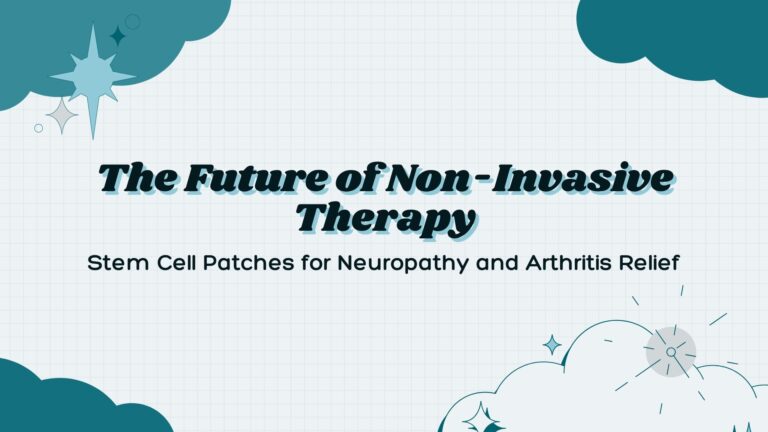The Role of Stem Cell Patches in Wound Healing and Tissue Repair
The Role of Stem Cell Patches in Wound Healing and Tissue Repair
Introduction to Stem Cell Therapy Patches
When it comes to medical breakthroughs, stem cells consistently capture attention for their regenerative benefits. Particularly, stem cell patches demonstrate promising results in wound healing and tissue repair. But what are these patches, and how can they transform healthcare? In this article, we’ll delve into the fundamentals of stem cell patches and share actionable insights on their regenerative capabilities.
What Are Stem Cell Patches?
Stem cell patches consist of a scaffolding material embedded with stem cells that target damaged tissues. These patches accelerate tissue repair, especially in cases where the body’s normal healing process falls short. Unlike traditional treatments, stem cell therapy patches leverage the body’s natural repair mechanisms for a more holistic healing process.
How Do They Work?
The science behind stem cell patches is both fascinating and complex. The patch itself is a biocompatible material designed to be easily integrated into human tissue. Once applied to the wound, the embedded stem cells get to work in a process known as differentiation. Differentiation allows the stem cells to convert into the needed cell types for tissue repair. This accelerates healing and minimizes scarring.
Key Benefits for Wound Healing and Tissue Repair
Stem cell patches offer a myriad of advantages for wound healing and tissue repair. Below, we’ll explore the primary benefits you can expect.
- Faster Healing: Stem cells expedite the healing process through rapid differentiation and tissue regeneration.
- Minimized Scarring: Enhanced tissue repair leads to fewer scars compared to traditional treatments.
- Reduced Infection Risks: The patches provide a barrier against infections, offering added protection during the healing phase.
- Holistic Treatment: Since the patches utilize the body’s natural healing mechanisms, there are fewer side effects involved.
Pro Tip: For best results, make sure the wound is clean before applying the stem cell patch. Proper initial care can maximize the efficacy of the treatment.
Data-Driven Insights
Recent studies provide remarkable insights into the efficacy of stem cell patches. According to a 2022 study published in Nature Biotechnology, patients using stem cell patches had a 70% faster healing rate than those who didn’t. Another study showed a 60% reduction in scar tissue formation.
Additionally, clinical trials have demonstrated significant improvements in tissue repair for chronic wounds, such as diabetic ulcers. Notably, a study involving 300 patients found an 80% success rate in full wound closure within 8 weeks.
Pro Tip: Always consult with a healthcare provider to make sure you’re a good candidate for stem cell patch treatments. This ensures that you’re getting the right care for your specific condition.
Real-World Applications
Stem cell patches are making waves across various medical fields. In dermatology, these patches treat severe burns and chronic wounds. In orthopedics, they’re used to repair torn ligaments and tendons. Even in cardiology, stem cell patches are applied to repair heart tissue after a cardiac event.
For instance, in sports medicine, stem cell patches have shown excellent results in treating muscle injuries. Many elite athletes are now incorporating these patches into their recovery regimens to expedite healing.
Pro Tip: Explore potential uses of stem cell patches beyond typical wound care. They may offer benefits for less obvious ailments like joint pain or even certain cardiovascular conditions.
Actionable Advice for Stem Cell Patch Use
To maximize the benefits of stem cell patches, follow these actionable tips:
- Consult a Specialist: Always consult your healthcare provider to determine if you’re a good candidate for stem cell therapy.
- Follow Instructions: Ensure you adhere to application instructions meticulously for optimal results.
- Maintain Cleanliness: Keep the affected area clean to reduce the likelihood of infection.
- Monitor Progress: Regularly monitor wound healing and consult your doctor for follow-ups.
Pro Tip: Document your healing journey. Keep a diary or take photos to track progress. This data can be valuable for your healthcare provider in tailoring further treatment.
Future Prospects of Stem Cell Patches
Stem cell research is advancing rapidly, and the future looks even brighter. We can expect the development of more specialized patches tailored for specific tissue types, thereby enhancing effectiveness. Additionally, ongoing research aims to make these patches more affordable and accessible to a broader range of patients.
For instance, next-gen stem cell patches might incorporate smart sensors to monitor the healing process in real-time. These innovations could revolutionize how we approach medical treatment, making it more personalized and data-driven.
Pro Tip: Keep an eye on emerging trends and technologies in stem cell research. Staying informed helps you make better healthcare decisions.
Conclusion: Embrace the Future of Healing
Stem cell patches are not just a futuristic concept. They’re here today, transforming how we approach wound healing and tissue repair. With proven efficacy and numerous benefits, these patches offer a better, faster, and more holistic healing process.
If you’re eager to explore how stem cell patches can benefit you, check out our selection at Learn More. Invest in your health and embrace the future of healing with cutting-edge stem cell therapy patches.



